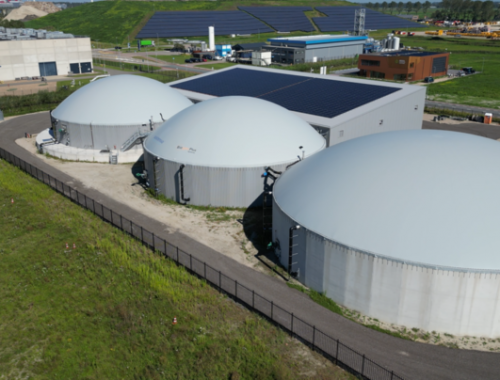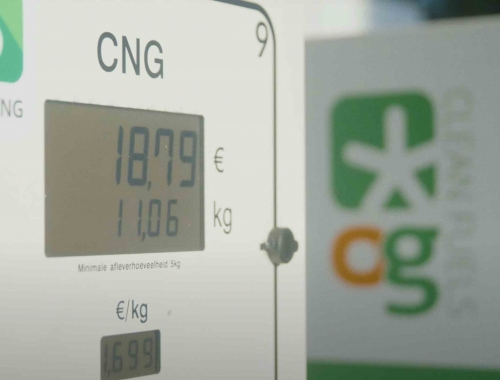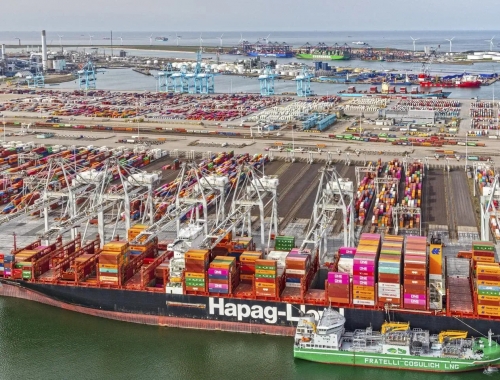Onyx Power to build blue hydrogen plant in Port of Rotterdam
SUMMARY
The plant will have a capacity of 1,200 MW and produce up to 300 kilotons of blue hydrogen annually.
By Gary LakesPOSTED IN:
The Port of Rotterdam announced in early April that German-based Onyx Power intends to build a blue hydrogen plant at its existing site in the port. The plant will have a capacity of 1,200 MW and produce up to 300 kilotons of blue hydrogen annually. Its goal is to advance the decarbonisation of industry and assist in meeting Holland’s national decarbonisation targets, the Port said in a statement.
Oynx “wants to make a significant contribution to emissions reduction in the Netherlands,” the statement said. The project is in keeping with Holland’s plan to develop blue hydrogen until green hydrogen becomes viable on a large scale. The plant is scheduled to come into operation in 2028.
The CO2 produced during the production of blue hydrogen is to be captured and stored in depleted offshore gas fields in the North Sea, as plans in the H-Vision Initiative concept call for. That could reduce CO2 emissions released into the atmosphere by 2.5mn metric tons/year.
Onyx Power, which was acquired by US private equity investor Riverstone from Engie in 2019, plans to construct the blue hydrogen plant next to its controversial coal-fired power plant on Maasvlakte 2 inside the port. When the coal-fired plant was built Engie promised the Dutch government that it would capture the CO2 produced, but that has not taken place, ChangeInc reported. An agreement between the Climate and Energy Ministry in 2021 called for the coal plant to close, but that has not happened and the power station continues to operate, but not at full capacity. The Onyx coal-fired plant is one of four still operating in the Netherlands and it produces some 3mn tons of carbon emissions annually.
Onyx has proceeded with securing the needed environment checks required for the hydrogen plant by announcing to the Environmental Protection Agency (DCMR) that an environmental impact assessment in accordance with the Environmental Management Act will be carried out. The company has also published the required Notitie Reikwijdte en Detailniveau (NRD), which outlines the scope of the assessment.
Berlin-based Onyx said that the blue hydrogen produced would be on an industrial scale, “which is urgently needed to reduce CO2 emissions from industry.”
The company currently operates five coal and biomass power plants with an installed generation capacity of around 2,350 MW.
“The location offers unique conditions for a timely and cost-effective start of blue hydrogen production,” Onyx said in a statement. “For example, the location is near existing infrastructure and key players across the entire value chain are in close proximity to the site.”
A necessary step in the energy transition
Blue hydrogen is a necessary step to rapidly reduce CO2 emissions from energy-intensive industries, the statement by Onyx said. “Until green hydrogen is available in large quantities at a competitive price, blue hydrogen can meet the demand for carbon-free hydrogen. Using the same infrastructure and production technologies, industries can gradually transition from blue to green hydrogen as the energy transition progresses. This way, blue hydrogen contributes to the rollout of green hydrogen.”
Blue hydrogen, like grey hydrogen, is made from natural gas or coal and water. Green hydrogen, for which Rotterdam plans to build several plants in the port area in the coming years, is made from renewable sources such as solar and wind energy and is considered the most sustainable hydrogen.
It has been reported that domestic production of blue hydrogen that uses carbon capture and storage (CCS) methods that sequester 90% of the CO2 produced and which is then stored away in depleted Dutch offshore gas fields would be two to three times cheaper than the production of green hydrogen.
That is an approach that many energy companies with long histories in hydrocarbons are taking as they begin to involve themselves in the energy transition.
Onyx is expected to use the steam methane reforming (SMR) method to produce hydrogen at its Rotterdam plant. SMR produces syngas, a combination of hydrogen and carbon monoxide, through the reaction of hydrocarbons and water. The main purpose of SMR technology is hydrogen production. It has so far shown to be the most common and cost-effective method for blue hydrogen production, and accounts for about 50% of the hydrogen produced in the world at this time.
According to the Abu Dhabi-based International Renewable Energy Agency (IRENA), global hydrogen production stands at around 75mn mt/yr as pure hydrogen and an additional 45mn mt/yr as part of a mix of gases. In 2018, the global production of hydrogen reached a total of 60mn mt, IRENA said. The hydrogen production market was valued at $130bn in 2020 and is estimated to grow by 9.2% annually through 2030.
Fast transition to hydrogen
The Netherlands is aiming for a rapid transition to a low-carbon economy and has placed ambitious greenhouse gas (GHG) reduction targets at the centre of energy and climate policy. This is reflected in the Dutch Climate Agreement which came into effect in June 2019. The accord set a goal for the production of 4 GW of power from green hydrogen production by 2030 and has since been upped to 8 GW. The government has also set GHG emissions reduction targets of 49% by 2030 and of 95% by 2050, compared to 1990 emission levels.
The Port of Rotterdam is a leading member of the H-Vision Initiative, which is designed to transition the port and surrounding area to a hydrogen economy beginning this decade. The H-vision concept is supported by the CO2 abatement strategies of the Rotterdam municipality, the Province of South Holland, the national government and the European Commission.
The H-vision consortium brings together a variety of companies, many of which operate in Rotterdam’s port and industrial area, such as Onyx. Together, they represent the entire hydrogen chain – from producers to end users. The Port of Rotterdam, Shell, Royal Vopak, ExxonMobil, Air Liquid and Deltalinqs are among the group.
The main focus of the H-vision programme is on the production of hydrogen using natural gas and refinery fuel gas. The CO2 that is released during production will be captured and stored in depleted gas fields under the North Sea. The concept involves converting hydrocarbon process gases into hydrogen using a process based on proven technology, such as SMR. The hydrogen will be burned directly in existing furnaces, which itself generates very little CO2.
A feasibility study carried out in 2019 by H-Vision under the direction of Deltalinqs and involving the participation of 16 companies and organisations, concluded that H-vision can deliver substantial CO2-reductions well before 2030. A recent update on the project’s website said the partners are ready to move into the next phase of the initiative having successfully introduced over the last four years the H-Vision concept as a viable CO2 abatement pathway. The website said that through detailed technical and engineering work, combined with in-depth economic analysis, the group has established the concept at national and European level as an acknowledged CO2 reduction alternative for hard-to-abate industrial heat.
The project is now expected to move ahead with plans that will advance blue hydrogen facilities. Those on the list will have a capacity to produce over 700 kilotons of blue hydrogen, enough to generate 3,200 MW of power, and enough to enable Rotterdam’s industrial sector to produce up to 20% of its required heat and power.
The Port of Rotterdam expects the first plant for hydrogen produced from natural gas and refinery fuel gas under the H-vision initiative to be ready by the end of 2026. It will have a capacity to fuel the generation of 750 megawatts.
Shell announced last summer that it would build “Europe’s largest renewable hydrogen plant” at Maasvlakte 2 in the Port of Rotterdam. The green hydrogen plant will use power from the Hollandse Kust Noord wind farm, in which Shell is a partner. The Holland Hydrogen I facility is to come into operation in 2025. It will have a 200 megawatt electrolyzer and produce 60,000 kilograms of renewable hydrogen every day.




